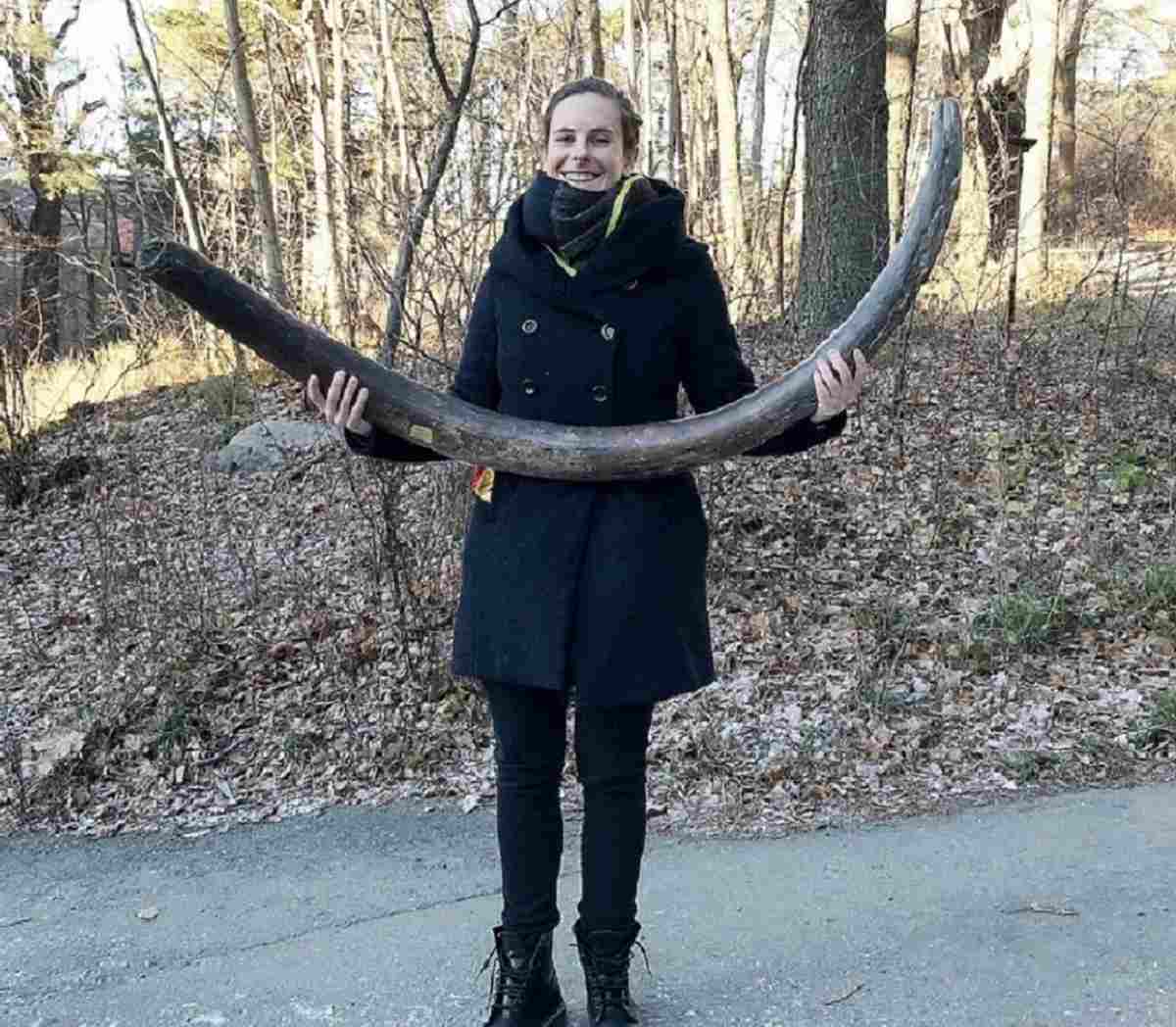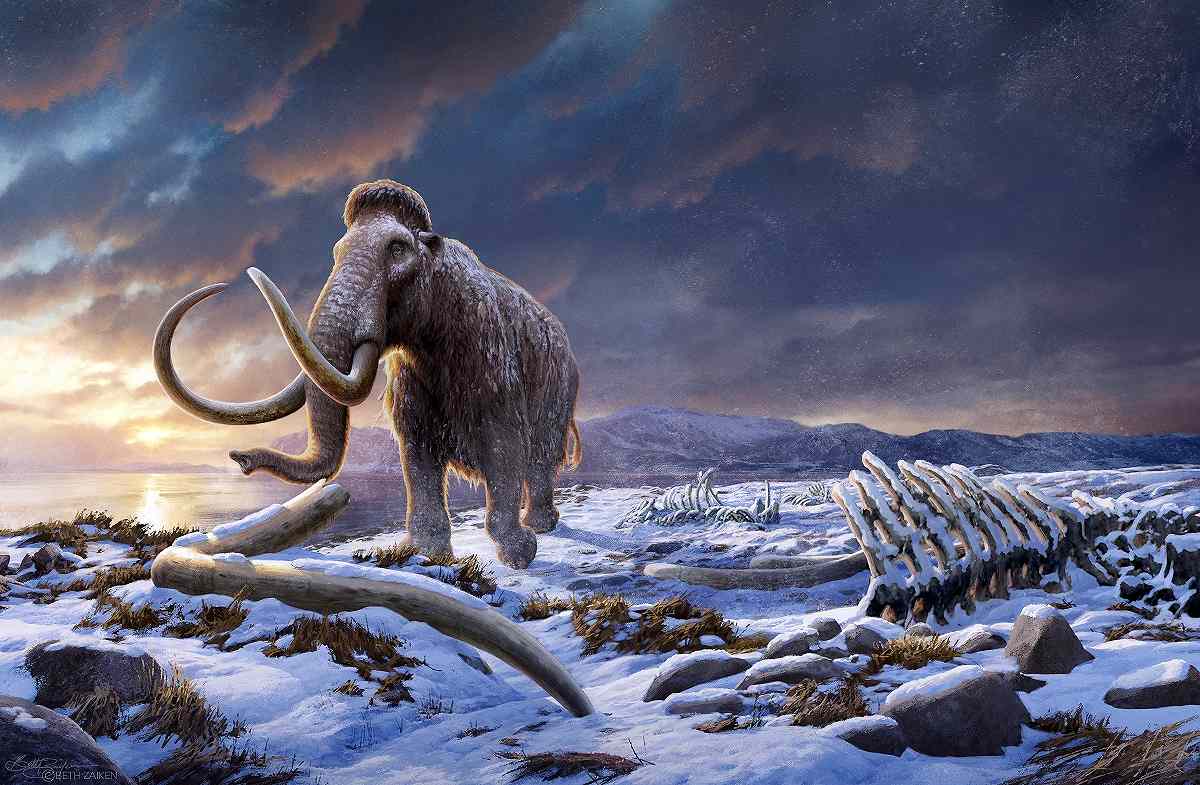
Evolutionary geneticist Marianne Dehasque holds a woolly mammoth’s tusk in Stockholm in 2018.
16:26 JST, July 5, 2024
About 4,000 years ago, the last of Earth’s wooly mammoths died out on a lonely Arctic Ocean island off the coast of Siberia, a melancholy end to one of the world’s charismatic Ice Age animals. But what doomed this last mammoth population on Wrangel Island? A new genomic analysis deepens the mystery.

An undated artist’s impression of the last woolly mammoth on Wrangel Island in the Arctic Ocean off the coast of Siberia
The study offers the fullest account to date of the inbreeding, deleterious mutations and low genetic diversity experienced by this population during 6,000 years of isolation on the island but concluded that, despite previous suggestions, these factors are unlikely to have doomed the Wrangel mammoths.
“This suggests that something else, and very sudden, caused the population to collapse,” said evolutionary geneticist Marianne Dehasque of Uppsala University in Sweden, lead author of the study published on June 27 in the journal Cell.
The researchers examined genome data obtained from the remains of 14 Wrangel mammoths and seven mammoths from a Siberian mainland population ancestral to the island dwellers, dating to up to 50,000 years ago.
As the Ice Age eased, the dry steppe tundra where mammoths long had thrived transformed, gradually from south to north, into wetter temperate forests amid rising global temperatures, confining these animals to Eurasia’s northernmost reaches.
“This is probably also how mammoths eventually ended up and became isolated on Wrangel Island, which lost its connection to the mainland around 10,000 years ago due to rising sea levels. It may have even been a single herd that populated the island,” Dehasque said.
The genome data indicated that the population isolated on mountainous Wrangel originated with at most eight individuals, then grew to 200 to 300 mammoths within about 20 generations — around 600 years — and remained stable.
The study detected reduced diversity in a group of genes crucial to the immune system. But while the mammoths slowly accumulated moderately harmful mutations, the most deleterious defects were disappearing from the population, apparently because individuals carrying these were less likely to survive and reproduce.
The study included no genomes from the population’s final 300 years, but such remains have now been unearthed and genomic analysis is planned.
Previous studies had attributed the extinction to accumulated genetic defects.
“The reason we don’t think inbreeding, low genetic diversity or harmful mutations caused the population to be doomed is that if that had been the case, the population should have gone through a gradual decline in size, where it dwindled toward extinction with an accompanying increase in inbreeding and loss in diversity,” said evolutionary geneticist Love Dalen of the Centre for Palaeogenetics, a collaboration between Stockholm University and the Swedish Museum of Natural History.
“But this is not what we see. There is virtually no change in inbreeding levels or genetic diversity throughout the 6,000 years the mammoths were isolated on the island. This means that the population size was stable through time,” Dalen added.
Human hunting also does not appear to have been the culprit.
“I agree that the mystery of the mammoths’ demise continues. From archeological evidence, we know that humans only arrived 400 years after mammoths went extinct,” Dehasque said.
“Fire hearths and habitation structures would be easy to find, as well as flint shards, reworked bones and tusks, et cetera. But there is simply no trace of humans having interacted with the mammoths on Wrangel,” Dalen added.
An infectious disease, possibly brought to the island by birds, is one possibility.
“Perhaps the mammoths would have been vulnerable to that given the reduced diversity we identified in the immune system genes. Alternatively, something like a tundra fire, a volcanic ash layer or a really bad weather season could have caused a really bad growth year for the plants on Wrangel. Given how small the population was, it would have been vulnerable to such random events,” Dalen said.
“In other words, it seems to me that maybe the mammoths just got unlucky. Had it not been for such bad luck, we would perhaps still have had mammoths around today,” Dalen added.
"Science & Nature" POPULAR ARTICLE
-

Mass Oyster Die-Offs Confirmed in Japan’s Seto Inland Sea; High Water Temperature Cited as Primary Cause
-

Genome Study Reveals Milestone in History of Cat Domestication
-

Big Leap in Quest to Get to Bottom of Climate Ice Mystery
-

Security Camera Footage Vulnerable to Outside Access; Investigation Finds 3,000 Pieces Exposed Online
-

Paws on Parade: Nairobi’s Dogs Dazzle at ‘Pawchella’
JN ACCESS RANKING
-

Keidanren Chairman Yoshinobu Tsutsui Visits Kashiwazaki-Kariwa Nuclear Power Plant; Inspects New Emergency Safety System
-

Imports of Rare Earths from China Facing Delays, May Be Caused by Deterioration of Japan-China Relations
-

University of Tokyo Professor Discusses Japanese Economic Security in Interview Ahead of Forum
-

Japan Pulls out of Vietnam Nuclear Project, Complicating Hanoi’s Power Plans
-

Govt Aims to Expand NISA Program Lineup, Abolish Age Restriction























